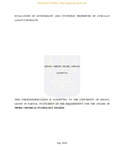UGSpace Repository
Evaluation of Antioxidant and Cytotoxic Properties of Citrullus Lanatus Extracts
JavaScript is disabled for your browser. Some features of this site may not work without it.
| dc.contributor.author | Ofosu-Aikins, P.A. | |
| dc.date.accessioned | 2018-11-30T14:53:57Z | |
| dc.date.available | 2018-11-30T14:53:57Z | |
| dc.date.issued | 2018-07 | |
| dc.identifier.uri | http://ugspace.ug.edu.gh/handle/123456789/26075 | |
| dc.description | Thesis (MPhil) | en_US |
| dc.description.abstract | INTRODUCTION Citrullus lanatus (watermelon) is well noted for its nutritional and therapeutic uses. The seeds and mesocarp of the fruit, which were of interest in this study are rich sources of phytochemicals including flavonoids and phenols. These bestow upon the fruit its medicinal properties such as antioxidant, anti-inflammatory, analgesic and anti-hypertensive activities. Cancer has been a public health menace for long and it currently stands as the world’s second killer disease. This owes to the fact that generally, lifestyle modifications keep occurring in the developing world, and the modes of treatment; chemotherapy, radiation and biological therapy are costly. Patients also tend to be resistant to therapy, and exhibit antagonistic side effects. Alternative sources of cancer therapy, particularly from plant sources, which transcend the accompanying problems of these current treatment methods thus are being researched into rigorously. This project therefore was aimed at evaluating antioxidant and cytotoxic activities of aqueous and organic Citrullus lanatus extracts. METHODS The study was comparative and employed the use of purposive sampling in the selection of the C. lanatus fruits. Aqueous extracts of C. lanatus mesocarp and seeds were prepared from distilled water by heating, filtration and centrifugation. The organic extracts (hexane, ethanol, ethyl acetate and chloroform) however were prepared by cold maceration and rotary evaporation. Antioxidant capacity of the extracts was assessed using 2, 2-diphenyl-1-picrylhydrazyl (DPPH), Folin Ciocalteau and total flavonoids assays. Cytotoxic activity of extracts on HL-60, Jurkat and Chang liver cell lines was evaluated using the 3-(4, 5-dimethylthiazol-2-yl)- 2, 5-diphenyltetrazolium bromide (MTT) assay. RESULTS The outcome of the project showed that the ethanolic seed and aqueous seed extracts have good total antioxidant activity with EC50 values of 0.57 mg/ml and 0.75 mg/ml respectively. Phenols were established to be present in all the extracts except the ethanolic mesocarp, with the ethanolic seed having the highest total phenolic content of 3943.23 mg gallic acid equivalent /100g of C. University of Ghana http://ugspace.ug.edu.gh x lanatus extract. Only five of the extracts had significant total flavonoid content, with the hexane seed having the highest of 1013.82 mg quercetin equivalent /100g of C. lanatus extract. For the cytotoxic assay, ethanolic seed extract exhibited the highest cytotoxic activity against HL-60 cells, whilst hexane mesocarp extract showed the highest anticancer activity against Jurkat cells with IC50 values of 65.39 μg/ml and 165.33 μg/ml respectively. Also, the ethanolic seed extract proved to be the most promising anticancer agent with a selectivity index of 12.6 for HL-60 cells. CONCLUSION The study demonstrated that five of the C. lanatus extracts possess significant antioxidant activity and most of the extracts exhibited significant anticancer activity. The organic and seed extracts generally exhibited greater activities than their aqueous and mesocarp counterparts, respectively. | en_US |
| dc.language.iso | en | en_US |
| dc.publisher | University of Ghana | en_US |
| dc.subject | Antioxidant | en_US |
| dc.subject | Cytotoxic | en_US |
| dc.subject | Citrullus Lanatus | en_US |
| dc.subject | Therapeutic | en_US |
| dc.subject | Diphenyltetrazolium | en_US |
| dc.title | Evaluation of Antioxidant and Cytotoxic Properties of Citrullus Lanatus Extracts | en_US |
| dc.type | Thesis | en_US |
